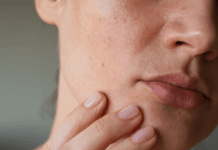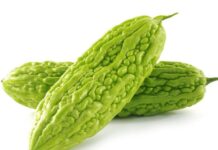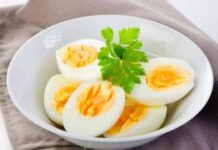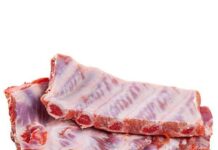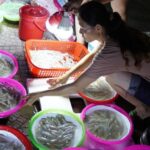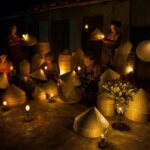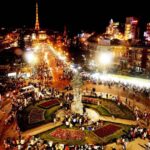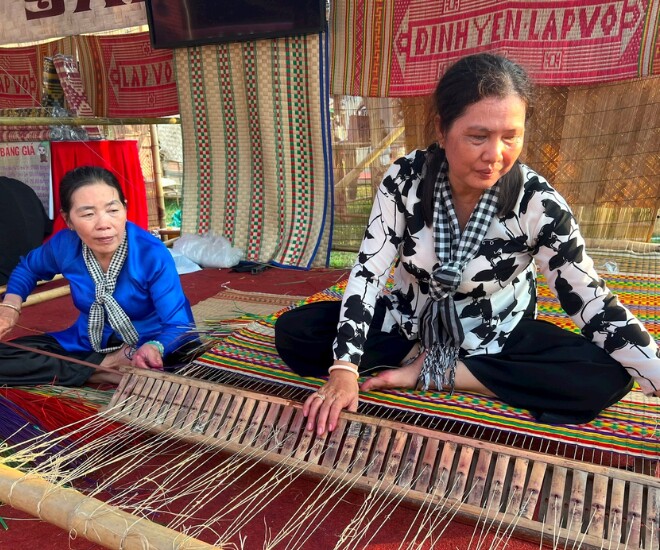
The art of weaving mats in this area dates back to the late 19th century and has been passed down and preserved through many generations.
The process of crafting Dinh Yen mats requires meticulous attention to detail, from selecting the right materials, drying, and dyeing to the actual weaving and final drying stage. Dinh Yen mats stand out for their vibrant colors and intricate patterns, reflecting the unique culture of Southern Vietnam and leaving a distinct mark on the traditional craft villages in this region.
Compared to the mat-making tradition in Northern Vietnam, the choice of raw materials is significantly different. The primary material used in Dinh Yen is a type of grass called “lac” and “bang” grass, which grows naturally in the vast fields. Locals harvest, dry, and then dye these grasses in various colors, including yellow, red, green, and blue.
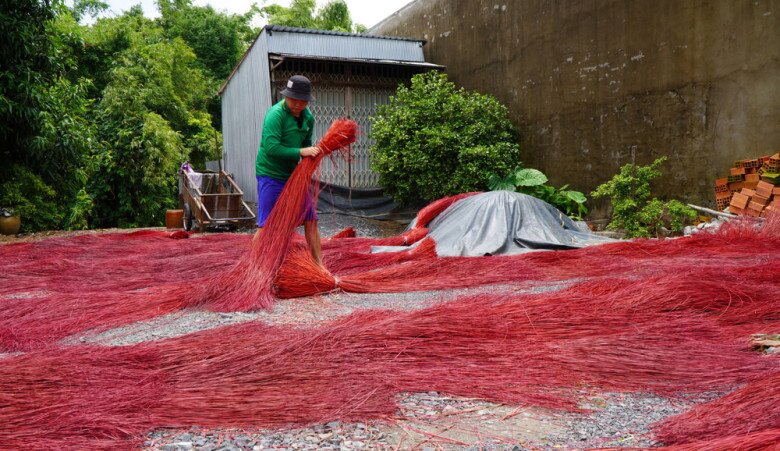
In the Dinh Yen mat village, you’ll find colorful strands of lac grass drying on the ground and hanging along the pathways. The rhythmic clacking of looms resonates throughout the village, from the first house to the last.
While the art of mat weaving is not overly complicated, it is a laborious process involving multiple steps such as cutting, drying, dyeing, and weaving. Weaving a mat typically requires two people to work together. Once the frame is set up, one person sits on the loom while the other threads the lac strands through, and the first person uses their strength to firmly beat the lac into place. This beating action must be decisive and strong enough to ensure the lac strands align perfectly without overlapping. Despite the availability of modern machinery that could speed up production and save time, the locals are committed to passing down this traditional craft to future generations to preserve this unique cultural heritage.
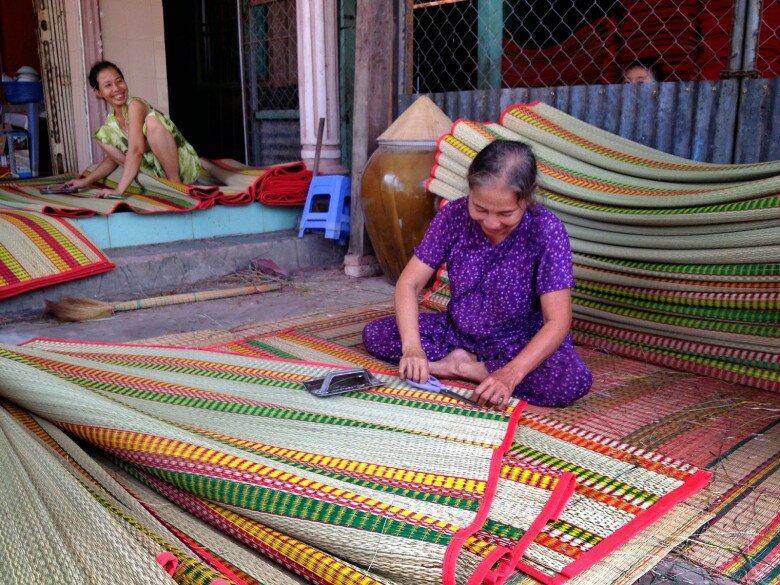
Weaving the mats is a skill that demands expertise. The artisans rely on their senses and experience rather than a predetermined color chart to create their masterpieces.
Once a mat is woven, it undergoes further steps of trimming, fabric sewing, and sun-drying. Among the various mat designs, the floral and spiral shell patterns are the most challenging to create, requiring precise distribution and intricate craftsmanship.
Today, the Dinh Yen mat village not only meets domestic demand but also exports its products internationally, contributing to the economic development of the region and preserving its traditional cultural values. Visitors to the Dinh Yen mat village can immerse themselves in the mat-making process and experience the warm hospitality of the local community.
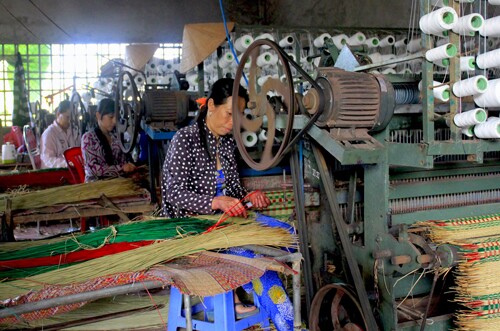
The vibrant, colorful mats, the bustling atmosphere of the mat-making process, and the warm hospitality of the riverine community all contribute to a unique cultural tourism experience that attracts visitors from near and far.
One activity not to be missed is the “ma” mat market, held periodically on Saturdays, sometimes extending from 10 PM to 4 AM the next day. However, to accommodate tourists, the market now opens its doors from 4 PM to 8 PM (check the official social media channels of Dinh Yen Ma Cho for the latest schedule). Unlike regular markets, the Dinh Yen mat market operates at night, creating a dazzling display of colorful mats illuminated by the soft glow of oil lamps.
The reason behind the night market lies in the past when, during the day, locals were busy tending to their fields or weaving mats, leaving only the evenings free for selling their wares. Traders, too, were occupied with other businesses during the day and would arrive in the evening to set up shop. Thus, the mat market naturally evolved into a nocturnal affair. In the courtyard of the ancient temple, beneath the flickering light of oil lamps, the marketgoers move silently like shadows, earning the market its nickname—the “ma” (ghost) market or the “am phu” (underworld) market.
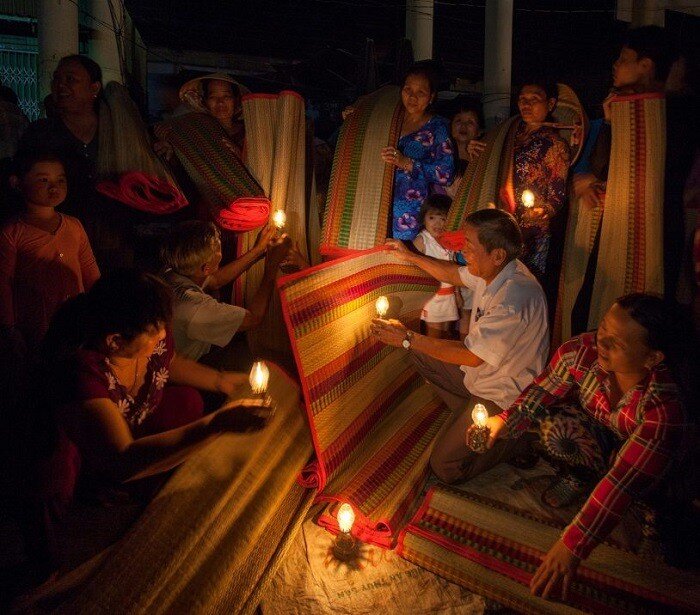
A unique feature of this night market is that buyers remain seated while sellers walk around, offering their mats for sale. The market buzzes with activity, creating a lively and vibrant atmosphere.
Beyond mat shopping, visitors can try their hand at mat weaving under the guidance of local artisans. This immersive experience offers a deeper understanding of the traditional craft and the intricate work involved. Additionally, guests can enjoy the melodies of “don ca tai tu” (Southern amateur music), a form of folk music unique to the region, and indulge in delicious traditional cakes.
The mats produced in Dinh Yen undergo a meticulous process, with artisans paying close attention to every detail. From selecting the right raw materials and dyeing them to achieve the desired colors to the careful drying process, each step is essential. Proper sun-drying ensures the lac strands are neither too damp nor too dry, resulting in durable mats. Thus, the mats of Dinh Yen village are known for their longevity, making them an ideal souvenir for tourists to take home to their loved ones, family, and friends.
The Ultimate Guide to the Unique Nghe An Delicacy Market: How a Quirky, Stall-less Wonder Attracts Crowds and Breaks Records
Stepping into Cua Lo on a summer’s night, visitors are greeted by a unique and captivating scene. Unlike traditional markets, the Nghė An Squid Market forgoes stalls and signs, instead opting for a simple yet enchanting setup. Here, you’ll find rows of boat baskets filled to the brim with freshly caught squid and friendly vendors ready to strike a deal. It’s a sight that truly comes alive under the starry night sky, offering a one-of-a-kind shopping experience.

